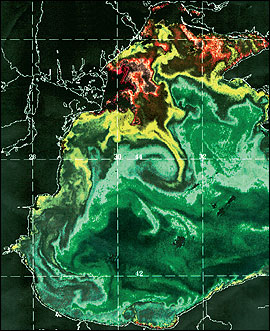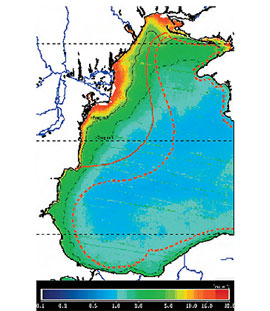 |
The Danube River Basin and the Black Sea: sharing the burdenThe daNUbs project presents an integrated assessment of the nutrient changes in the Danube Basin and their impacts on the Black Sea ecosystem. |
 |
Satellite imagery shows the nutrient discharge from the Danube to the
Black Sea, with areas in red having the highest algae density. |
The main findings of the daNUbs project show that the situation in the northwestern Black Sea shallow waters has improved considerably since the early 1990s due to reduced nutrient input. Nevertheless, economic and agricultural development in the Danube Basin may reverse the improvement of the quality of the ecosystem, if nutrients are not managed properly.
Bringing problems downstream.
Beginning in the 1970s to the early 1990s, the Black Sea coastal
area suffered from chronic harmful algal blooms, oxygen deficiencies, as
well as mass mortalities of wildlife. An excessive input of nutrients was
to blame for this development, and the Danube River was identified as the
major source of nutrients in the Black Sea ecosystem. In particular, eutrophication
problems close to the mouth of the Danube Delta as well as on the coast
north and south of the Delta are a direct result of Danube influence. In
the north the effects are intensified by influences from rivers Dniestr
and Dniepr.
Management of nutrients to avoid excessive discharges through the river
system into the coastal areas must consider the whole basin. Agriculture
driven by the demands of human nutrition, waste water management, as well
as combustion processes are the main sectors causing nutrient discharges
from the land to the sea. In the year 2000, the daNUbs project, 'Nutrient
management in the Danube River Basin and its impact on the Black Sea', began
an integrated assessment of the nutrient changes in the Danube Basin and
their impacts on the Black Sea ecosystem as a basis for the development
of efficient nutrient management strategies.
The daNUbs project.
The Institute for Water Quality of the Vienna University of Technology coordinated
the daNUbs project, supported by the EU-5th framework research programme.
The daNUbs project team consisted of 40 scientists from 17 institutions
in a wide range of disciplines. From the beginning, the ICPDR contributed
to the development and success of the project as advisor to the consortium.
The project finished in March 2005, and results have influenced and been
integrated into the work of the ICPDR on several occasions - in the work
of expert groups, a workshop on nutrients as transboundary pressure, the
Danube–Black Sea Stocktaking Meeting, and the EU Water Framework Directive
roof report for the Danube Basin.
 |
Summary of 800 satellite images
which shows zones of intensive (red and yellow) and moderate(green)algae
blooms in the years 1998 to 2002 as compared to the situation in the
1980s (intensive algae blooms: red line; moderate algae blooms: red
dotted line) |
Good news, for now.
The main findings of the daNUbs project show that the situation in the Black
Sea shallow waters has improved considerably since the early 1990s due to
reduced nutrient input. Eutrophication levels have decreased and water transparency
has increased, with an improvement of the near bottom oxygen regime. The
Black Sea has experienced a regeneration of phytoplankton and other organisms
necessary for the health of the ecosystem. Zooplankton is only regenerating
slowly and fish stock is still out of balance. The improvements are the
result of decreased nutrient discharges to the Black Sea. These low discharges
are due to improved nutrient removal from waste water in Germany, Austria
and the Czech Republic, and reduced phosphate discharges from detergents
in other countries.
The threat and the solution.
For sustainable development of the Black Sea ecosystem, the nutrient discharge
from the Danube River should be further diminished or at the very least
kept at the present level. Policy measures have to be proactive and should
focus on continuous and long term control of all sources of nutrients: waste
water management, agriculture and combustion processes.
To avoid deterioration of the current situation, national governments should
declare the total area in the Danube Basin as sensitive under the Urban
Waste Water Directive. This would facilitate financial support for waste
water treatment with nutrient removal. Furthermore, policy measures to limit
nutrient emissions from agriculture are necessary - measures based on the
best available agricultural practices for reduction of nutrient losses from
agricultural areas and a limitation of the intensity of agricultural production.
Such a management policy would protect ground and surface water quality
and abate coastal eutrophication in Black Sea shallow waters.
For more information visit: http://danubs.tuwien.ac.at/